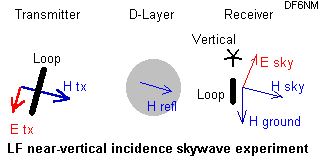Hi LF-group,
yesterday I put together a small receiving loop for DF, and did a check
tonight on the broadband DGPS signal above 122.5 kHz from Frankfurt. I was
quite surprised to find that close to the loop minimum, the sound of the
noise-like modulation very much varied with the pointing angle, and the
effect was similar to selective fading on shortwave. In one position about 5
degrees offset, the spectrum contained a deep null, which moved across the
band and changed its depth over a few minutes. Apparently I am seeing the
superposition of the (attenuated) groundwave plus a variing-delay skywave,
whose polarisation has either been modified by Faraday rotation along the
path or by a horizontal current-component in the transmitting antenna.
This observation brings up another thought: Has someone tried to measure
skywave reflection on LF at near-vertical incidence?
Difficulties could be expected in separating the skywave from the
well-propagating groundwave, and sub-millisecond time resolution will be
ineffective with a narrowband amateur signal. LORAN could possibly provide
that, but their Marconi antennas are useless here due to their zenith null.
However, transmitting with a magnetic loop over ground will produce vertical
skywave and groundwave radiation with equal efficiency. For example, Walter
(DJ2LF) has successfully operated a large rotatable tx-loop in his garden two
years ago. The attached graph lines out a proposed experiment to measure
skywave phase and amplitude at steep incidence:
The transmitting station orients its loop close to the ground-wave minimum,
e.g. 5 deg offset would provide 21 dB reduction. The receiver, say 20 km
away, operates two antennas,
- a magnetic antenna, precisely nulled to the groundwave, but almost
maximally sensitive to the (unrotated) skywave polarization (cos 5° = 0.996),
- a vertical electrical antenna which picks up the weak groundwave as a phase
reference. If needed, it may be decoupled from the loop using a
high-impedance rx input.
With a skywave path on the order of 200 km, both components will have
comparable fieldstrength. Amplitude and differential-doppler measurements
over several hours should show the reflectivity and changing altitude of the
D-layer.
If both stations can share a common clock (eg TV stn, VHF link), the
groundwave reference would be expandable, and the TX loop could also be
directed towards the minimum, providing further isolation.
73
Markus, DF6NM

|

